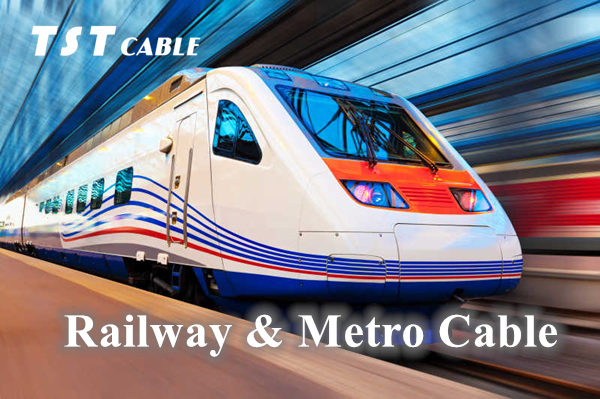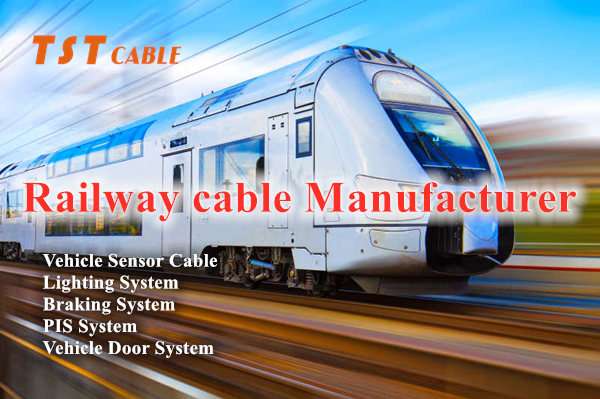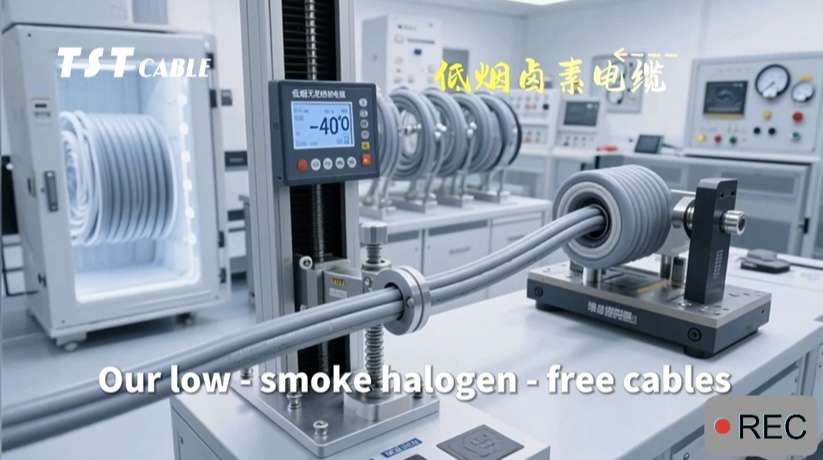
Do you know what applications of railway cable are there? What are the railway standards in different countries? railway cable play a vital role in modern transportation systems. They are widely used in different systems and components to ensure the safe, reliable and efficient operation of rail transit. TST CABLES, a well-known Chinese rail transit cable manufacturer, summarizes some typical applications of railway cable and the differences in railway standards in different countries, hoping to help interested friends.
- Application of railway cable
- Power transmission
Single-core power cable: used for the transmission of main power supply, such as the power supply of traction motors.
Multi-core control cable: used for control circuits and connecting various electrical equipment, such as switches, relays, etc. - Control and signal
Data cable: used for communication systems within trains and between stations to transmit data and instructions.
Sensor cable: used to connect various sensors, such as temperature sensors, speed sensors, etc., to monitor the status of trains. - Communication system
Communication cable: used for communication between trains and between trains and ground control centers. - Monitoring and safety
DC feeder cable: used for current monitoring in power supply systems to ensure safe operation.
Fire-retardant cable: used in critical areas to reduce the risk of fire. - Special applications
Flat cable: used in space-constrained areas such as door control systems and interior lighting.
Thin-wall insulated cable: suitable for internal distribution cabinets and power supply systems of high-speed trains due to its lightweight and compact design. - Power distribution system
Low-voltage power cable: used for low-voltage power distribution systems inside vehicles.
High-voltage power cable: used for high-voltage power transmission between vehicles. - Other applications
Jumper cable: used to connect electrical equipment between vehicles.
Emergency cable: used for backup power transmission in emergency situations.
Technical features of railway cable
Fire-retardant: ensures that in the event of a fire, the cable can slow down the spread of flames and reduce the generation of smoke and toxic gases.
Low smoke halogen free:(LSZH cable) use environmentally friendly materials to reduce the emission of harmful substances during combustion.
Weather resistance: able to withstand extreme temperature changes and humidity changes.
Mechanical strength: sufficient tensile strength and abrasion resistance.
EMC (electromagnetic compatibility): ensure that the cable works normally in a complex electromagnetic environment and avoids interference with other electrical equipment.
Examples of rail transit cable applications:
Urban subway: use low-smoke halogen-free flame-retardant power cables to improve safety.
High-speed trains: use thin-wall insulated cables to reduce weight and improve energy efficiency.
Intercity railways: use high-performance data cables to achieve high-speed communication between trains and stations.
- Railway standards in European countries
- French RATP railway standards
RATP (Régie Autonome des Transports Parisiens) is mainly responsible for the public transportation network in the Paris area, including subways, trams, etc. Its cable standards usually cover the cable requirements for electrical equipment, signal systems, and communication systems in subway and tram systems. These standards may emphasize the requirements for cable fire resistance, weather resistance, mechanical strength, and electromagnetic compatibility.
Main features of French RATP railway standard cable products
Fire resistance: RATP has strict requirements on the fire resistance of cables, especially for underground subway lines. Cables may need to be certified to French national standards such as NF F16-101 to ensure that smoke and toxic gases are effectively limited in the event of a fire.
Material selection: For improved safety and environmental protection, low smoke zero halogen (LSOH) materials may be preferred. This material produces less smoke when burned and does not contain halogens, thereby reducing the emission of harmful substances.
Mechanical properties: The cable needs to be able to withstand the vibration and physical stress in subway operation, so it needs to have a certain tensile strength and abrasion resistance.
- German DB Railway Standard
DB (Deutsche Bahn AG) is the main railway operator in Germany. German railway standards are generally very strict and focus on safety and reliability. For cables, this may mean high standards of fire retardancy requirements, good mechanical durability and chemical corrosion resistance. In addition, the cable needs to meet strict electromagnetic compatibility standards to ensure compatibility with signal systems and other electronic equipment.
Main features of German DB Railway Standard Cable Products
EMC (Electromagnetic Compatibility): German railway standards may require cables to have excellent EMC performance to ensure mutual compatibility with other electrical equipment. This may involve the design of the cable shielding layer to reduce electromagnetic interference.
Chemical resistance: Cables may need to be able to withstand a variety of chemicals, such as oil, diesel and detergents.
Temperature range: Cables need to be able to maintain good electrical performance over a wide temperature range, from extremely cold to high temperatures.
- UK NETWORK RAIL Standards
NETWORK RAIL is the owner and manager of the UK’s railway infrastructure. British standards may pay special attention to the safety, reliability and ease of maintenance of cables. For example, cables may need to comply with BS (British Standards) standards and have good tensile strength and bending radius to facilitate installation and reduce the risk of damage.
UK NETWORK RAIL Standard Cable Product Main Features
Maintenance Ease: To simplify the maintenance process, cables may need to have an easily identifiable marking system and the ability to quickly connect and disconnect.
Fire performance: Similar to France, the UK also attaches great importance to the fire performance of cables, especially for underground railway systems.
Durability: Cables may be designed to have a long life to reduce maintenance costs.
- Spanish RENFE Railway Standard
RENFE (Red Nacional de los Ferrocarriles Españoles) is the state-owned railway operator in Spain. The Spanish standard may focus more on performance stability in high temperature environments, as parts of the country have high summer temperatures. Cables may need to withstand extreme temperature changes and maintain good electrical performance.
Main features of Spanish RENFE Railway Standard Cable Products
High temperature adaptability: Cables may need to be able to operate at higher temperatures, especially in high summer temperatures.
UV protection: For cables exposed to sunlight, strong UV protection may be required to avoid material aging.
Water resistance: Cables may need to have good waterproof performance, especially in places such as tunnels and bridges.
- Belgian SNCB Railway Standard
SNCB (Société Nationale des Chemins de Fer Belges) or NMBS (Nationale Maatschappij der Belgische Spoorwegen) is the national railway company of Belgium. The Belgian standard may focus more on the cable’s cold resistance and moisture resistance, as the country has a relatively humid climate.
Main features of the Belgian SNCB railway standard cable products
Moisture resistance: The cable may need to have excellent moisture resistance to cope with the rainy climate of Belgium.
Cold resistance: The cable needs to be able to maintain good flexibility at lower temperatures to avoid embrittlement in cold winters.
Mechanical strength: The cable needs to have sufficient mechanical strength to cope with daily mechanical stress.
- Swiss SBB railway standards
SBB (Schweizerische Bundesbahnen) is the national railway company of Switzerland. Swiss standards may place special emphasis on cable durability and performance in high-altitude conditions. Due to the changing terrain of Switzerland, the cable may need to be able to withstand extreme temperature changes and complex geographical environments.
Main features of Swiss SBB railway standard cable products
High altitude adaptability: Given the mountainous terrain of Switzerland, the cable may need to be able to maintain stable electrical performance at high altitudes.
Cold resistance: The cable needs to be able to maintain good electrical and physical properties in severe cold conditions.
UV resistance: For outdoor applications, the cable may need to have strong UV protection to extend its service life.
Each railway standard reflects the characteristics and special needs of its respective country. For example, France and the UK attach great importance to the fire resistance of cables, while Germany places more emphasis on the EMC performance of cables. Spain and Switzerland emphasize the performance of cables under high temperature and high altitude conditions respectively. Understanding these specific requirements helps ensure that the cables can meet the needs of specific railway environments. If you need detailed advice for specific countries and projects, it is recommended to work with TST CABLES, a professional railway engineering cable manufacturer, to ensure that the selected cables meet the relevant railway standards.
TST CABLES – Your trusted partner for customized rail transit cable solutions
In this era of rapid change, challenges and opportunities, TST CABLES is always committed to being your most solid backing. We are well aware of the different customs and customs of various countries, and the unique challenges and high standards of the railway industry in different countries. Therefore, our cable products not only meet the railway standards of China CRCC, France RATP, Germany DB, UK NETWORK RAIL, Spain RENFE, Belgium SNCB and Switzerland SBB, but also exceed customer expectations. TST CABLES rail transit cable EN50264 cable series and EN50306 series cable products have obtained CRCC certification. At present, more than 500,000 cables have been installed on more than 3,500 high-speed rail coaches, with a running mileage of more than 6,000,000 kilometers.
Safety and reliability: We know that every train departure is a commitment to life. Therefore, our cables use advanced fire-resistant materials to ensure maximum protection of the lives of passengers and staff in emergency situations. Whether traveling through the underground tunnels of France or speeding on the high-speed railways of Germany, our cables can provide excellent performance, making every journey full of peace of mind.
Durability and maintenance convenience: We are well aware of the importance of cable durability and easy maintenance. Our products are carefully designed to maintain long-term and stable working conditions under various harsh conditions, while ensuring easy installation and maintenance, reducing downtime and maintenance costs. Because we believe that every minute of smooth operation is a reward for the trust of passengers.
Technological innovation and sustainable development: TST CABLES has always been at the forefront of customized cable technology, constantly exploring new materials and new processes to provide more efficient and environmentally friendly products. Our cables not only meet the current railway standards, but are also widely used in mechanical industrial equipment, construction, rail transportation, automobiles, marine vessels, medical, aerospace, power generation, chemical industry and oil and gas extraction, and pave the way for future sustainable development. Because we firmly believe that it is our common responsibility to protect the better tomorrow of the earth.
We look forward to working with you to create a safer and more efficient future of railway transportation and make every trip a wonderful memory.
If you have a need for customized railway cables, further technical support or customized cable solutions, you can visit the TST CABLES official website or send an email to the professional cable engineer of TST cable manufacturer at any time (email: lixiangchao@testeck.com, please state your country, your industry, and your needs in the email).
Also available in:
English




